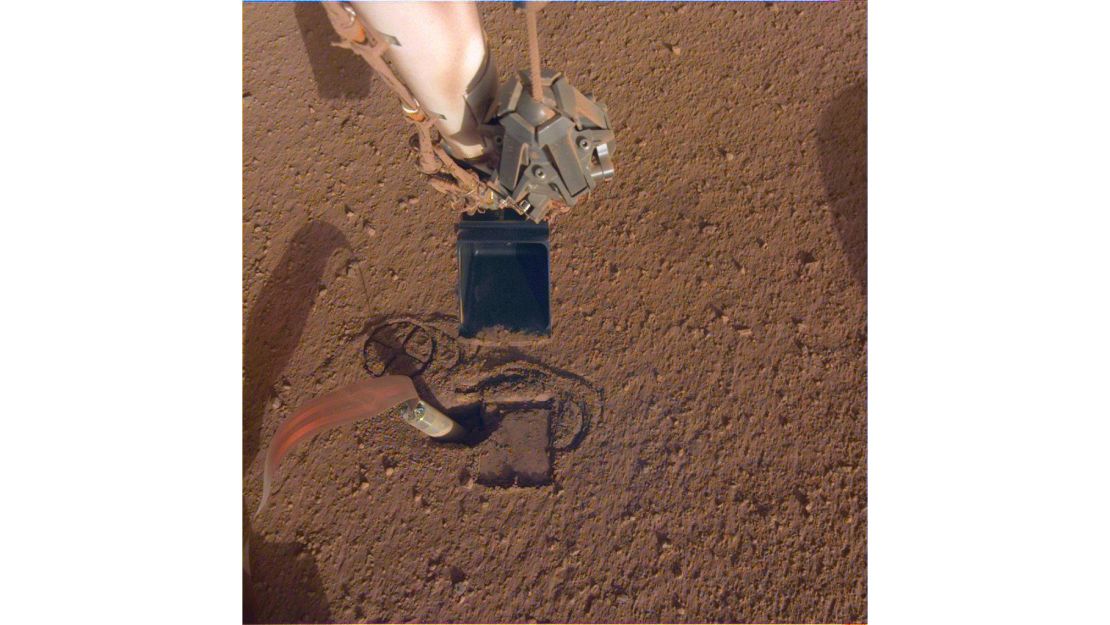Since landing on Mars in November 2018, NASA’s InSight mission has been taking selfies, providing daily Martian weather reports, detecting quakes on Mars and hearing strange sounds. But its heat probe experiment is struggling to burrow beneath the surface of the Red Planet.
While the Curiosity rover is currently exploring Gale Crater, InSight is a stationary probe permanently parked in Elysium Planitia. It’s along the Martian equator, bright and warm enough to power the lander’s solar array year-round.
InSight, or Interior Exploration using Seismic Investigations, Geodesy and Heat Transport, is a two-year mission to explore a part of Mars that we know the least about: its deep interior.
The suite of geophysical instruments on InSight sounds like a doctor’s bag, giving Mars its first “checkup” since the planet formed. Together, those instruments take measurements of Mars’ vital signs, like its pulse, temperature and reflexes — which translate to internal activity like seismology and the planet’s wobble as the sun and its moons tug on Mars.

But “the mole,” or the self-hammering heat probe, has only dug roughly 14 inches into the surface since February 28. It was designed to reach at least 16 feet beneath the surface to record how heat escapes from the interior, according to NASA.
The mole seems to be missing a key factor in digging: friction in the surrounding soil. Instead, the team believes that the probe is simply bouncing in place. Applying extra pressure may be a solution.
“We’re going to try pressing the side of the scoop against the mole, pinning it to the wall of its hole,” said Sue Smrekar, InSight deputy principal investigator at NASA’s Jet Propulsion Laboratory in Pasadena, California. “This might increase friction enough to keep it moving forward when mole hammering resumes.”
Relocating the mole isn’t the solution because it wasn’t designed to be moved once it began digging.
The mole, known as the Heat Flow and Physical Properties Package, was provided by the German Aerospace Center. In June, the experiment’s team used the spacecraft’s robotic arm to remove a structure keeping the mole steady so they could get a more direct view of what happened when the mole tried to dig.
A camera on the arm revealed between two to four inches of duricrust beneath the surface. Duricrust is a hard crust at or near the surface of the ground typically formed by the accumulation of upward migration and evaporation of ground water.
This soil that seems cemented together is thicker than what the mole was designed for. And it’s nothing like the soil that previous Mars missions have run into before.
“All we know about the soil is what we can see in images InSight sends us,” said Tilman Spohn, principal investigator for the experiment. “Since we can’t bring the soil to the mole, maybe we can bring the mole to the soil by pinning it in the hole.”
Over the last few months, the team used a scoop on the robotic arm to push and poke at the soil, hoping it would collapse the soil. But the arm can’t use its full strength to push.
This is because the mole is as far away as it can be from the spacecraft so it wouldn’t lead to false temperature readings.
“We’re asking the arm to punch above its weight,” said Ashitey Trebi-Ollennu, the lead arm engineer at JPL. “The arm can’t push the soil the way a person can. This would be easier if it could, but that’s just not the arm we have.”















